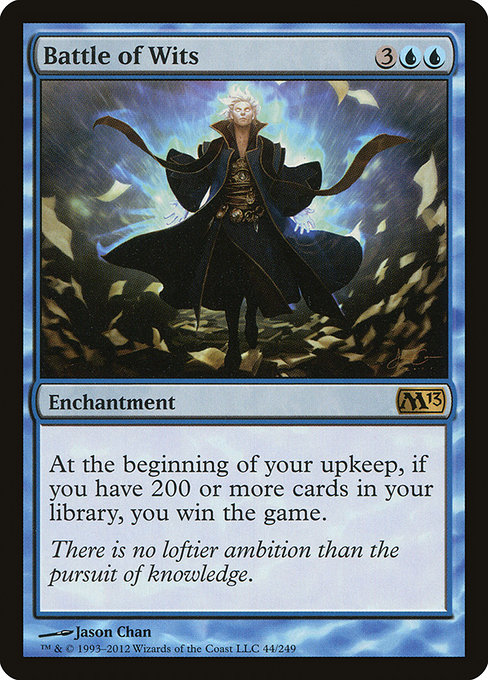
Image courtesy of Scryfall.com
Parody Cards and the Battle of Wits Moment
Investing in parody MTG cards isn’t about quick flips or flash-in-the-pan memes. It’s about reading a culture that loves the game as much for its lore as for its clever, sometimes defiant humor. The real-world anchor for this exploration is a blue enchantment from Magic 2013 that sits at the intersection of intellect and inevitability: Battle of Wits. 🧙🔥💎 The card’s premise—win the game when your library swells to 200 cards—turns a familiar draw-go mind game into a literal long-term test of patience, probability, and deck-building audacity. And yes, the card’s aura and flavor text feel tailor-made for playful parodies that celebrate knowledge as power. ⚔️🎨
Background: the real card
Battle of Wits costs 3UU and appears in the Magic 2013 core set as a rare enchantment. It has both foil and nonfoil finishes, which means collectors can chase a slightly more premium variant, much like many official cards in a modern collection. Its oracle text is crisp and unforgettable: “At the beginning of your upkeep, if you have 200 or more cards in your library, you win the game.” The flavor text—“There is no loftier ambition than the pursuit of knowledge.”—speaks directly to the card’s abstract appeal: the joy of accumulation, strategy, and intellectual swagger. The art, created by Jason Chan, rounds out a package that many players remember fondly as a quintessential blue puzzle card. In market terms, this is a mid-tier staple that can show up in price charts as a steady, if modest, performer. The card’s practical play in formats like Modern, Legacy, and Vintage also helps keep it relevant among collectors who value long-term potential. 🧩
What makes parody cards resonate with collectors?
Parody cards rise and fall with the same currents that shape mainstream cards: rarity, quality, and cultural resonance. When a parody card channels a well-known mechanic or a beloved moment—especially something as evocative as a library-piling win condition—it earns a place in the broader conversation about MTG’s history and humor. Collectors often look for:
- Story and flavor: Parodies that nod to a card’s lore or famous lines can become talking points at tables and conventions alike. 🗣️
- Limited runs and licensing: Projects tied to artists or licensed partners can create scarcity that drives interest and value—though legality and licensing are key considerations for any serious collector. 📜
- Artistic reinterpretations: A fresh art treatment or high-quality print variation can elevate a parody item from novelty to collectible. 🎨
- Timely memes and nostalgia: A parody card that taps into a lasting meme or a wave of nostalgia can enjoy staying power beyond a single season. 🎲
There is no loftier ambition than the pursuit of knowledge.
Investment potential: the core takeaways
When we translate the Battle of Wits framework into parody-card dynamics, several core principles emerge that apply broadly to the category:
- Foundational mechanism matters: The real card’s 200-card-win condition anchors expectations. Parody prints that riff on layered, clever interactions tend to hold interest longer than simple, one-note gags. 🧠
- Rarity and print quality: Official prints with foil variants often carry a premium. In the real card’s market data, foils typically fetch higher prices than non-foils, reflecting scarcity and demand. Parody prints that replicate premium finishes or come from reputable artists can attempt to ride a similar arc. 💎
- Format relevance and community glue: Battle of Wits is legal in Modern, Legacy, Vintage, and Commander, which helps sustain a niche but loyal audience. Parody cards that cater to evergreen formats risk long-term appeal, provided licensing and production standards are solid. ⚔️
- Provenance and condition: The value of parody cards is often tethered to who created them and how many exist. A well-documented, high-quality run or collaboration can outperform mass-produced items. 🎭
Parsing the numbers: where Battle of Wits sits in market reality
Beyond its immediate gameplay use, Battle of Wits offers a pragmatic baseline for assessing break-even and upside in related prints. In its own right, the card sits at a modest price point in non-foil form and exhibits a modest premium for foils. This dynamic illustrates how non-essential enchantments from a popular set can still maintain a steady collector’s interest, especially when they tell a story or spark joyful memories at the table. The valuation is not a rocket ship, but it’s the kind of steady drift that patient collectors can appreciate. For parody projects, the story becomes more nuanced, as licensing, artist reputation, and production quality interact with cultural timeliness to shape any potential upside. 🚀
In the broader parody-card landscape, the path to meaningful gains is less about a single print and more about a credible ecosystem: a well-curated lineup, a respected creator roster, and a recognized platform that offers limited, licensed runs. Diversification across established staples and high-quality parody prints—under a trusted framework—helps mitigate risk and keep passion aligned with potential value. 🧩
As you browse for inspiration, the cross-promotion angle is worth noting. The product linked below offers a delightful way to bring MTG vibes into daily life—customizable desk mouse pads that celebrate the game’s whimsy while keeping your workspace stylish. It’s a lighthearted reminder that the MTG hobby isn’t only about winning—it's about collecting moments as well as cards. 🧙🔥🎲